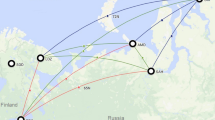We present the results of the experimental studies of the features of superlong-distance and round-the-world propagation of the HF waves in the radio lines with different orientation and length, which were obtained in 2012–2014 using a new method of oblique ionospheric sounding. The frequency–time travel intervals of the direct round-the-world signals, their amplitude-frequency and angular-frequency characteristics are determined. The mechanism of propagation and transformation of the round-the-world signals due to the radio-wave refraction by the transverse electron-density gradients in the region of approach of two optimal paths passing via the transmitter and receiver so that each path forms the smallest angle with the terminator. It is shown that the proposed mechanism is in good agreement with the experimentally observed variation of the azimuth of the direct round-the-world signal on the Cyprus–Rostov-on-Don path and on the Alice Springs (Australia)–Rostov-on-Don path in the absence of variation of the direct round-the-world signal azimuth. For the superlong-distance propagation of the HF waves on the Virginia (USA)–Yoshkar-Ola and Puerto Rico–Yoshkar-Ola (the distances about 8000–10000 km) paths, the best propagation conditions are observed when the entire path is in the illuminated ionosphere near the terminator boundary making a small angle of 10°–25° with the terminator.
Similar content being viewed by others
References
A. V. Gurevich and E. E. Tsedilina, Long Distance Propagation of HF Radio Waves, Springer–Verlag, Berlin (1985).
V. P. Uryadov, N. V. Ryabova, V. A. Ivanov, and V. V. Shumaev, J. Atm. Terr. Phys., 57, No. 11, 1263 (1995).
R. B. Fenwick, Round-the-World High Frequency Propagation, Tech. Rep. No. 71 of Stanford Electron. Lab., Stanford Univ. Stanford, California, USA (1963).
S. F. Golyan, Radiophys. Quantum Electron., 18, No. 9, 1014 (1975).
A. V. Gurevich, L. M. Erukhimov, V. Yu. Kim, et al., Radiophys. Quantum Electron., 18, No. 9, 964 (1975).
G. G. Vertogradov, V. P. Uryadov, E. G. Vertogradova, and A. A. Ponyatov, Radiophys. Quantum Electron., 53, No. 3, 161 (2010).
V. A. Bubnov and G. A. Rumyantsev, Radiophys. Quantum Electron., 18, No. 9, 1023 (1975).
G. G. Vertogradov, V. P. Uryadov, V. G. Vertogradov, and S. V. Kubatko, Patent No. 2399062 RF. Chirp Ionosonde, Publ. on September 10, 2010, Bull. No. 25.
The United States and Australia memorandum of agreement on radar activities. Data fusion project arrangement: Techn. doc. No. 3043. Final report. Space and Naval Warfare Systems Center (1998). 183 p.
P. E. Pace, Detecting and classifying low probability of intercept radar. Artech House Inc. (2009).
The Akrotiri military antennae health survey: Final report. Department of Medical Physics and Oncology University of Bristol (2005).
V. P. Uryadov, G. G. Vertogradov, V. G. Vertogradov, et al., Radiophys. Quantum Electron., 52, No. 4, 241 (2009).
G. G. Vertogradov, V. P. Uryadov, V. G. Vertogradov, et al., Élektromag. Volny Elektron. Syst., 15, No. 5, 22 (2010).
A. A. Kolchev, V. V. Shumaev, and A. O. Shchiryi, Izv. Vyssh. Uchebn. Zaved., Priborostr., 51, No. 12, 73 (2008).
A. A. Kolchev, V. V. Shumaev, A. G. Chernov, et al., Proc. XVI Int. Sci. Techn. Conf. “Radar, Navigation, Communicat.” (RLNC’2010), Voronezh (2010), vol. 2, p. 797.
sec.noaa.gov.
G. G. Vertogradov, V. P. Uryadov, E. G. Vertogradova, et al., Radiophys. Quantum Electron., 56, No. 5, 259 (2013).
V. I. Sazhin and M. V. Tinin, Radiophys. Quantum Electron., 18, No. 9, 1028 (1975).
A. A. Ponyatov and V. P. Uryadov, Computer Simulation of Ionospheric Propagation of HF waves, Preprint No. 428, NIRFI, Nizhny Novgorod (1996).
M. V. Tinin, Issled. Geomagn. A´eron. Fiz. Soln. [in Russian], Nauka, Moscow (1973), No. 29, p. 157.
M. Ichinose, Y. Kuratani, and I. Yamazaki, J. Radio Res. Lab., 32, No. 136, 61 (1985).
Author information
Authors and Affiliations
Corresponding author
Additional information
Translated from Izvestiya Vysshikh Uchebnykh Zavedenii, Radiofizika, Vol. 57, No. 6, pp. 464–483, June 2014.
Rights and permissions
About this article
Cite this article
Ponyatov, A.A., Vertogradov, G.G., Uryadov, V.P. et al. Features of Superlong-Distance and Round-the-World Propagation of HF Waves. Radiophys Quantum El 57, 417–434 (2014). https://doi.org/10.1007/s11141-014-9524-7
Received:
Accepted:
Published:
Issue Date:
DOI: https://doi.org/10.1007/s11141-014-9524-7



